ATCOM R1L IP Phone Review
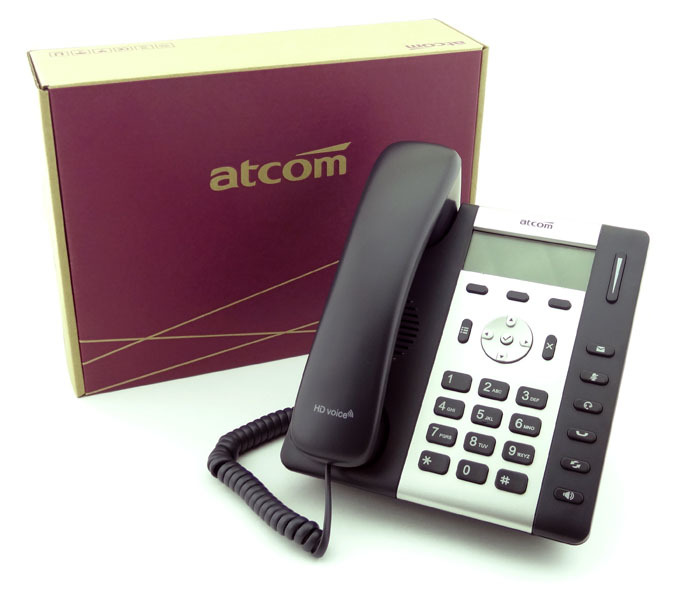
ATCOM is not well known on the Russian market for VoIP equipment, despite its rather long presence on it. Those few users who still had experience with ATCOM equipment speak about it more likely in a negative way. In the overwhelming majority of cases, this is due to the fact that this experience was gained when working with devices from quite ancient model series, such as, for example, the ATCOM AT530 IP Phone.
Indeed, those devices were far from the best in their price category - they did not differ either in their special reliability, nor in functionality, or appearance. Since that time, ATCOM has released as many as four new IP phone line models, each of which was undoubtedly better than the previous one. With one of the results of such progressive progress - IP-phoneATCOM R1L - we will meet today.
The ATCOM R SIP phone series includes 4 models and their various modifications. The hero of this review - ATCOM R1L is the simplest and budget phone line. His place is on the tables of ordinary employees of companies, and his task is to reliably and efficiently perform the most basic and popular telephone functions in the office. It would seem, what else can you write about this phone, especially for a whole review? On such devices it is customary to say either bad or nothing. However, do not rush to conclusions - the ATCOM R1L IP phone has some very interesting features that are sometimes inaccessible to devices of a much higher price segment.
Design and ergonomics
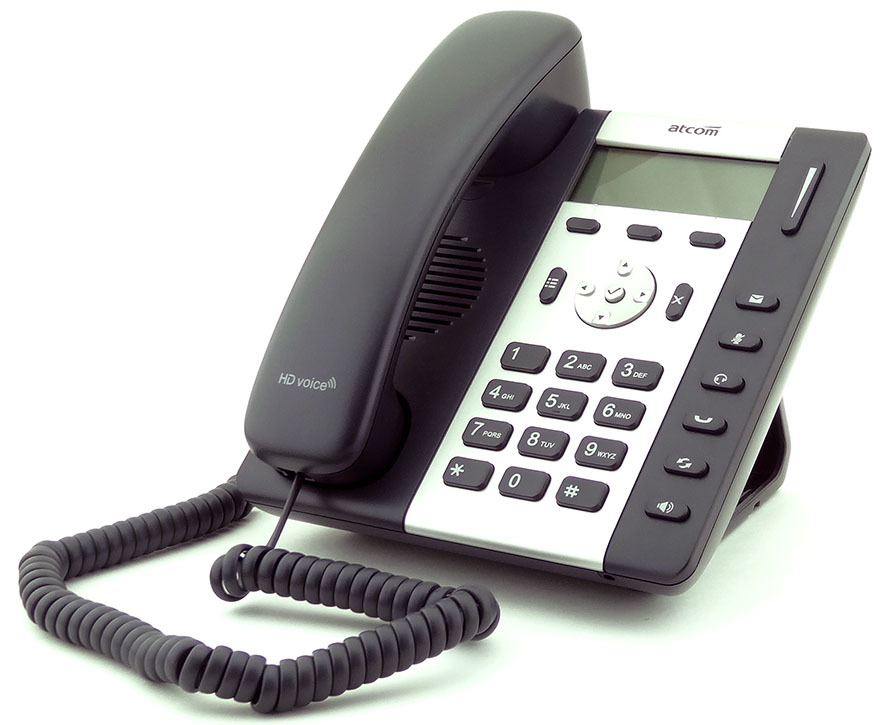
But we will begin with the appearance of the phone. Design is a subjective thing, I personally like the R1L very much, however, like the entire ATCOM R series. I find the combination of dark and silver very interesting, and the plastic itself looks very high quality.
The keys of the dialer, too, do not cause any questions - they are large, with minimal roundings, it is almost impossible to miss by pressing. All the necessary for the IP-phone entry-level function keys are present. The only complaint - to the four-way navigation keys: pressing it fuzzy, without feedback. If the manufacturer replaced one large key with four separate keys, it would be much more convenient to control them to navigate the menu.
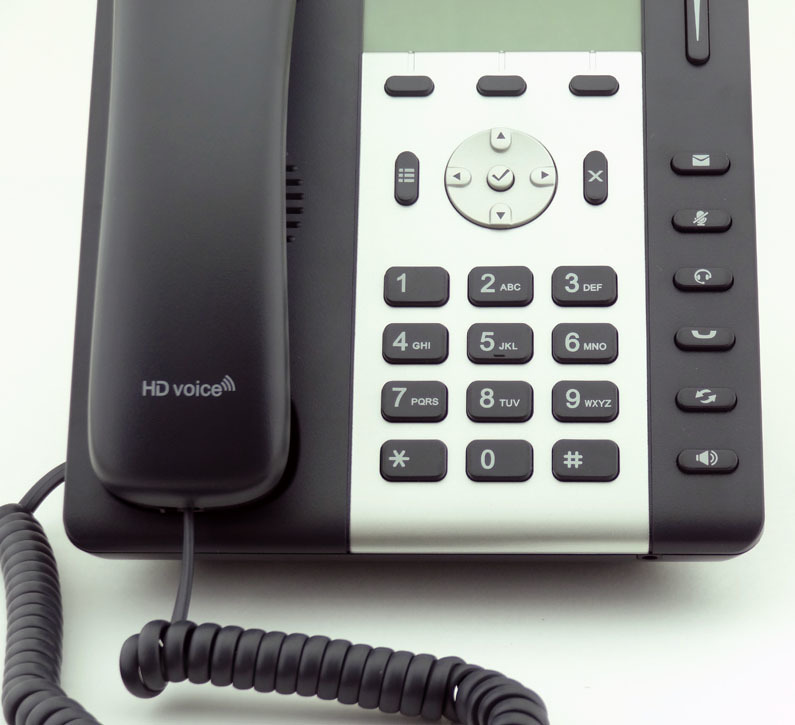
We'll talk about the ATCOM R1L handset separately. In the meantime, we note that due to the very massive upper and rather thin middle part, it is very convenient to remove and hang up the phone. In her hand, she lies confidently, does not slip, there is no need to experience any discomfort during a long conversation. However, there is a small flaw here: the landing pad under the tube is not very well fitted in shape, which is why the tube is lying too loose on it. Because of this, sometimes there are two incidents: firstly, when you try to pick up the phone, you can accidentally reset the call. Secondly, an unsuccessfully placed handset may not fully press the lever and not complete the call. Fortunately, after a timeout, the phone itself resets the call, and the cases described still occur quite rarely.

Display
Returning to appearance, it is fair to note that when turned off, the phone looks a bit more advantageous than when turned on. The reason for this paradox lies in the display. Yes, for an entry-level phone, a 3-inch display is pretty good. But the resolution of 132x52 pixels for such a screen is clearly not enough. For example, the display at Yealink SIP-T19, though smaller (2.3 inches), but because of the higher pixel density, it reads much better. In defense of ATCOM R1L, it is worth noting the screen backlight - it will be easier to work with the phone on a summer sunny day than with the same Yealink SIP-T19, which has no display backlight.
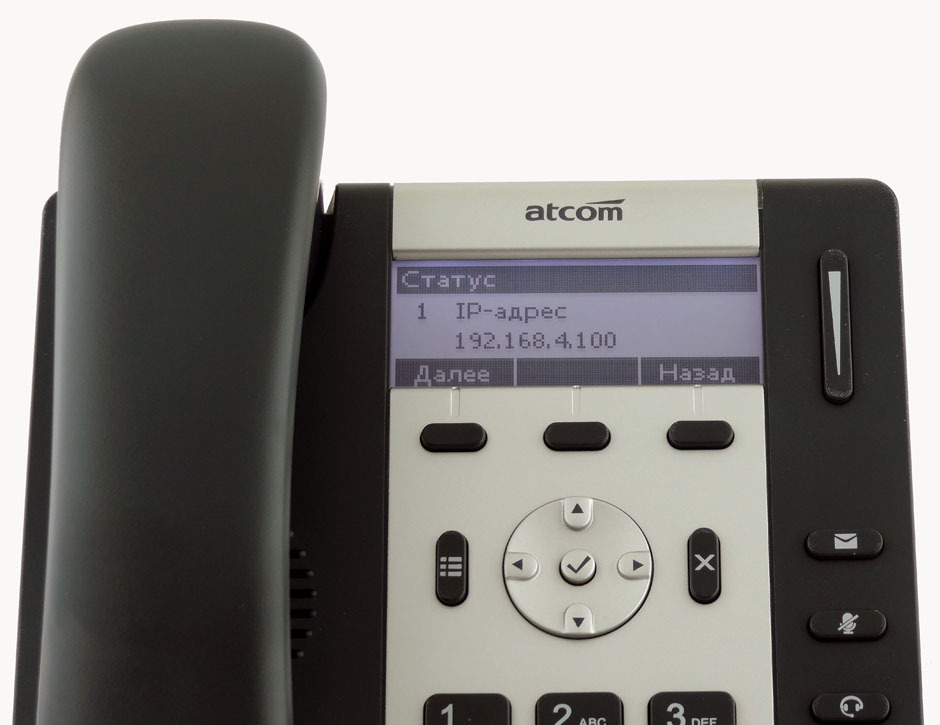
Due to the low resolution of the display, the interface of the phone is also not optimal. For example, when scrolling through the menu, only two items fall on one page, and when viewing the call history, there is only one entry. If you want to find some old call, you will have to look through it for quite a while. However, do not forget that we are talking about an entry-level phone, in the production of which it is almost impossible to do without compromises.
Ports
ATCOM R1L ports are absolutely standard. These are two network ports, two 4P4C connectors for connecting the handset and headset, as well as a power connector. There are no USB ports, no ports for connecting additional expansion modules, there are no SD slots for the entry level phone. The same can be said about the support of the gigabit network - it is only available for the older models of the line, while the R1L has one hundred megabit network. For those who want to power the phone via PoE, the R1L model is also not suitable; instead, it will have to take a slightly more expensive ATCOM R1 model.
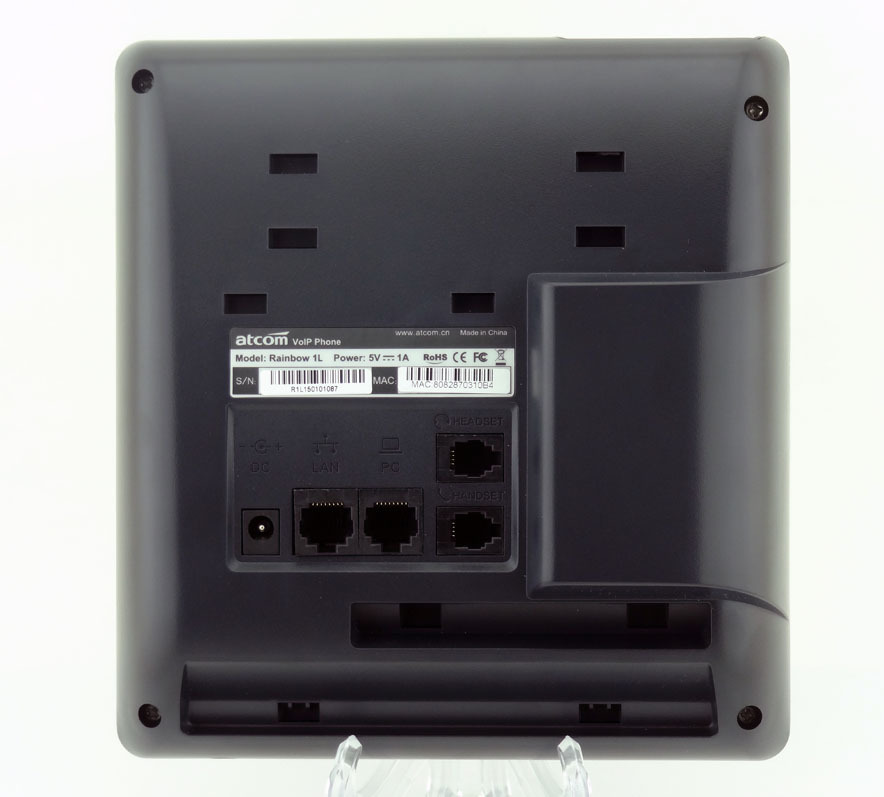
Without moving away from the back of the phone, we note that the angle of inclination of the stand of the R1L is not adjustable. However, the slope set by the manufacturer is quite convenient. The possibility of wall mounting the device is also provided for this purpose special clips are included.
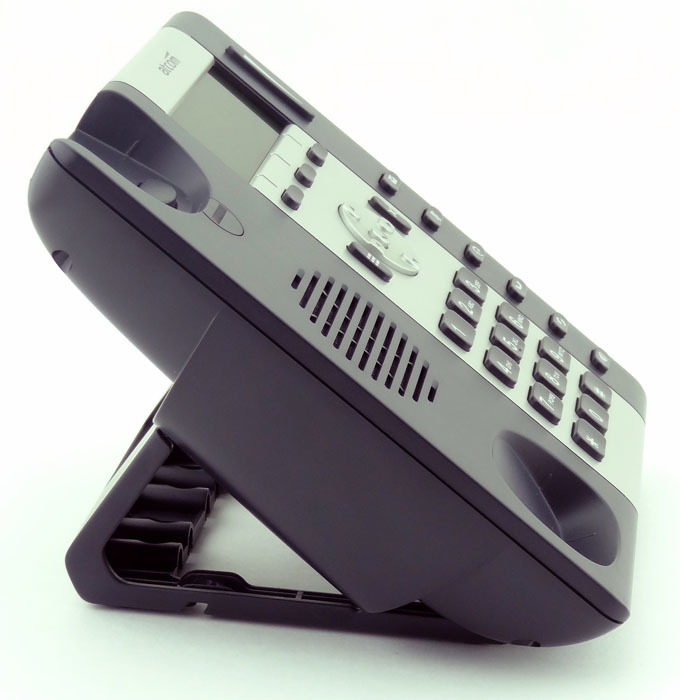
Sound quality
So we got to one of the most important characteristics of any telephone set. The number of additional functions, display size, appearance - all this fades into the background, as soon as we remember that the phone was created to speak on it. And when it comes to entry-level IP phones, then fade into the background, hand on heart, often just nothing. In this case, the quality of the reproduced sound becomes not only important, but the most important criterion for evaluating the telephone as a whole.
It seems that they understand this very well in ATCOM. And to the credit of the manufacturer, it is worth noting that sound quality was given special attention not only when writing marketing materials (as is the case with other companies), but also when creating a telephone. Talking on ATCOM R1L is really very comfortable: the sound reproduced by the handset is clear, deep and very clear. This is especially noticeable in comparison with other devices, for example, the Grandstream phones of the budget series GXP1620 / 1625. If the sound differs slightly when using the G722 wideband codec, then with narrowband codecs the difference in favor of the ATCOM R1L is already quite noticeable. But it is precisely narrowband codecs G711 and G729 that are the most frequently used today.
ATCOM marketers explain the high sound quality of their phones by the presence of silicone gaskets, gaskets, gold-plated contacts and other superstitions. In my opinion, the reasons for the excellent sound are much simpler - it is the use of high-quality dynamics and the design of the tube in which this speaker is located. It is easy to see that the upper part of the ATCOM R1L tube is much more massive than that of most other IP phones. This provides not only an excellent tube weight distribution, but also increases the reverberation time, which makes the sound a bit richer and deeper.
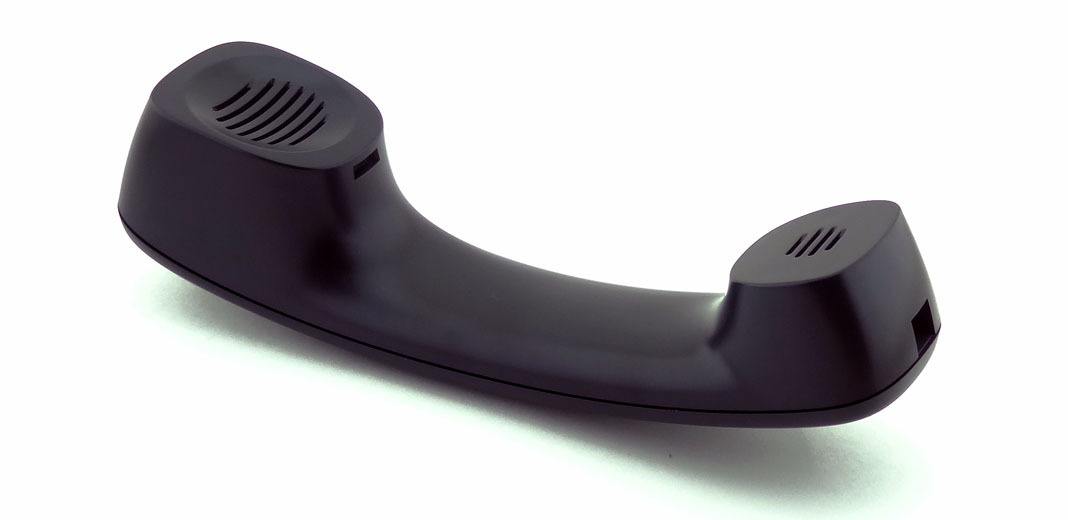
Summarizing the above: behind the “HD Voice” text on the ATCOM R1L telephone handset is more than just support by the G722 wideband codec. ATCOM engineers have worked well on sound quality and the results of their work are noticeable "with the naked ear."
Speakerphone
When at the beginning of the article I mentioned the unique features of ATCOM R1L, I first of all meant the quality of the speakerphone. In a nutshell - it's great. Seeing this very easily by comparing the sound with other low-cost IP-phones. For example, Yealink SIP-T19 is very close to R1L when talking on the handset, but in hands-free mode, the difference is just huge. At the budget phone Grandstream GXP1620, by contrast, the speakerphone leaves the best impression, but it does not reach the ATCOM R1L speakerphone. You shouldn’t compare the Fanvil C58 phone - the speakerphone is clearly not his thing.
Something similar in sound quality was found only in the much more expensive Grandstream models GXP2140 and GXP2160. And all the same, the sound of the R1L is perceived to be more saturated due to better reproduction of low frequencies. Again, there is no need to look for any miracles - the whole thing is in the design of the phone. Pay attention to the special reverberation camera located right under the speakerphone - this is the main reason for the excellent sound quality.
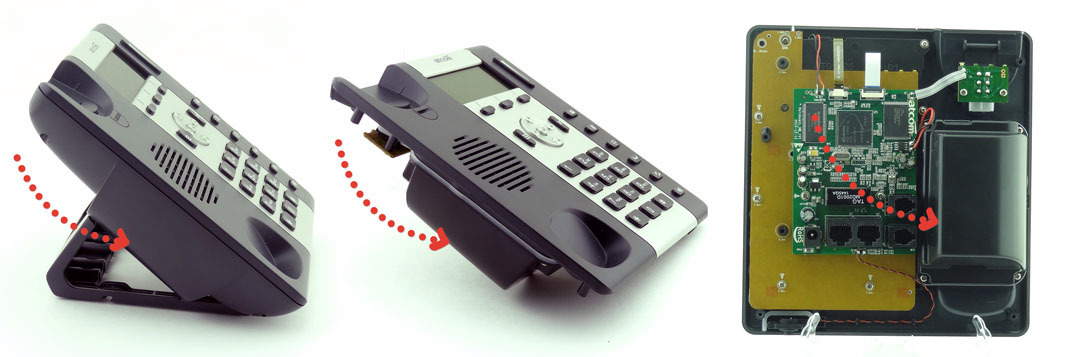
Some paradox, however, is that the speakerphone - one of the main trump cards of ATCOM R1L - in real life can be used quite rarely. The main users of this function are middle and top managers sitting in separate offices, and for them the R1L model is clearly not up to its status. But, first, do not forget that in the ATCOM model range there are other models of the R series, and all the compliments towards the ATCOM R1L speakerphone are fully applicable to them.
Secondly, the use of the speakerphone is not limited to a point-to-point telephone conversation. The speakerphone is so good that it can also be used for small conferences. Of course, you should not flatter yourself - ATCOM R1L highly specialized conference telephones are not a competitor: the built-in microphone does not have the required radiation pattern, and there is no possibility to connect additional microphones. But for organizing a meeting in a small room for 3-5 people, the model R1L will fit perfectly.
Iron
Sometimes when working with some non-consumer electronic devices, a persistent feeling arises, as if it had returned ten years ago. While smartphones, tablets and other gadgets have already overcome all conceivable values by the number of pixels, gigabytes and gigahertz, manufacturers of specialized electronics seem to be in no hurry to leave the past decade.
Unfortunately, this reproach is also true for many IP phones. And it seems at first glance - to our today's hero as well. Indeed, a small monochrome display with a resolution of 132x52 pixels is, perhaps, not quite what we would like to see in the 21st century. But let's not judge only by appearance - let's see what is inside the ATCOM R1L IP phone.

And there, XWAY INCA-IP2F, a powerful dual-core MIPS processor from Lantiq, which was formed in 2009 as a division of Infineon, and bought by Intel in 2015, serves as the central chip. In theory, this chip is far superior in performance ARM-processors DSPG DVF9918, which are widely used in most budget IP-phones. In practice, the ATCOM R1L full load speed is about 20 seconds, which is two times faster than the Yealink SIP-T19 E2 and Grandstream GXP1620, which use DSPG chips. Of course, download speed is one of the most insignificant parameters for an IP phone. But thanks to the use of a much more powerful processor, the R1L works very smartly, without braking and freezing - that is, exactly as a modern electronic device should work.
Ease of use
Making and receiving calls, holding and switching between calls, transferring a call are, perhaps, all the functions that 95% of owners of budget IP-phones use. Naturally, this basic functionality is fully implemented in ATCOM R1L and its use does not cause any difficulties. The only thing missing is the line selection keys, it would be much more convenient to switch between calls with them. There are two lines for ATCOM R1L, but only one SIP account. This means that you can receive a second call with the first one active, but you cannot set up a second account on your phone - no.
As for the Russification, the phone menu and the Web-interface are translated into four, the documentation - on a solid five. There are both brief instructions for installing and performing basic functions, as well as a full-fledged Russian-speaking user manual.
Convenience settings
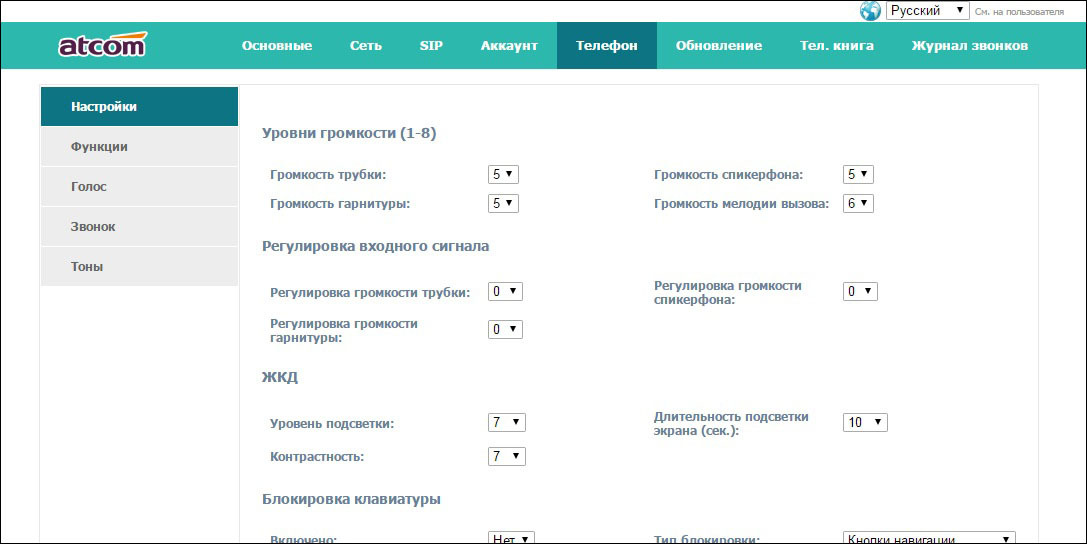
The basic configuration of the phone can be done using the on-screen menu, but this is not entirely convenient, it is better to use a fairly logical and understandable Web-based interface. To set up a large number of phones, there is an auto-provinging function — the ATCOM R1L configuration file can pick up from both HTTP (S) and FTP or TFTP servers. If necessary, the configuration file can be encrypted using AES.
Telecom operators may be interested in the RPS function, which provides an opportunity to sell a fully pre-configured phone to a customer. It works as follows: the operator registers on the ATCOM website, indicates the MAC addresses of the phones sold to them and the address of the server on which the configuration files for these phones are located. By default, the devices, when loaded, access the ATCOM servers and get the address of the server for autotuning. From this server, they receive the configuration files prepared by the operator at their MAC address. The client simply needs to connect the phone to the network with Internet access and turn it on, and it will register automatically. It turns out pretty customer-oriented service.
Network protocols
A few words about ATCOM R1L supported network technologies. First of all, this is the 802.1Q VLAN - the de facto standard for modern IP phones, since their allocation to a separate virtual subnet when used in the office is good and correct. Secondly, it is support for L2TP VPN, which is very convenient when it comes to the need to securely connect phones from remote locations. For those who are overcome by listening mania, the phone provides support for encrypting voice traffic using the SRTP protocol.
Total
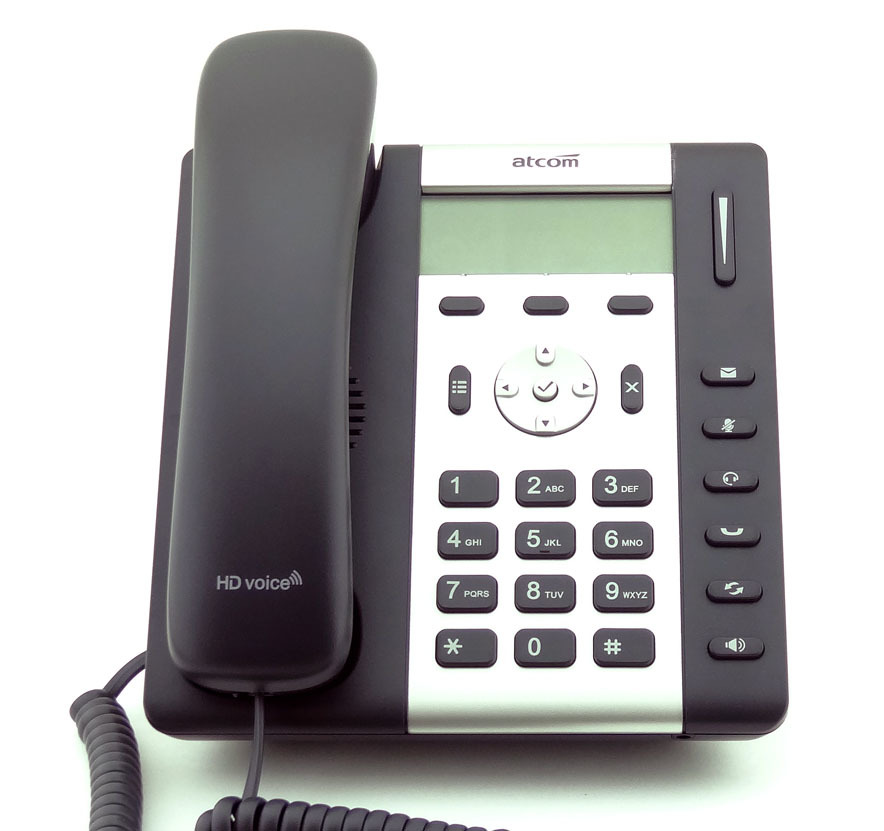
What exactly can not blame the hero of our review - so it is in facelessness. ATCOM R1L - a very interesting IP-phone with several distinct pluses. These include a stylish design, excellent quality of communication, both in normal and loud modes, as well as high speed of work due to the use of high-quality iron. There are no obvious flaws in the phone: yes, I would like a slightly better display, but for an entry-level device, this is more a wish than a necessity.
Buy ATCOM R1L retail can be for $ 57. The low price and the above-described advantages of the phone make it possible to use it as the main device in the office - on the tables of ordinary employees of the company.
